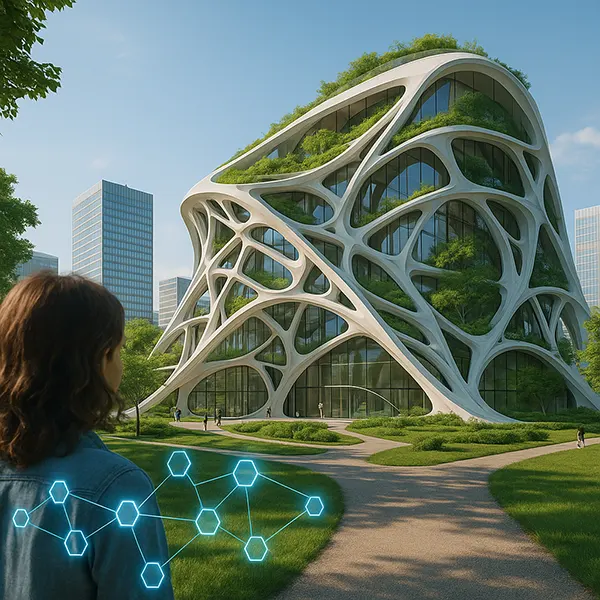Generative Design in Architecture: When Buildings Are Designed by AI

Generative design has reshaped various industries, and in architecture, it is proving to be more than just a trend. By leveraging the power of artificial intelligence and computational logic, architects and engineers are beginning to design buildings that are not only visually stunning but also highly efficient and sustainable. This approach is particularly relevant in 2025, as the need for responsive urban development grows globally.
The Role of AI in Generative Design
At the core of generative design is a system that uses algorithms to explore numerous permutations of a solution, based on input constraints and goals. For architects, this means specifying spatial requirements, material limitations, energy consumption goals, and cost boundaries. The AI then produces multiple feasible design options, allowing human experts to evaluate and refine the results.
Tools like Autodesk’s Generative Design and Spacemaker, now part of Autodesk’s suite, are widely used in urban planning and individual building projects. By June 2025, leading architectural firms integrate these tools into their workflow, achieving faster iteration and improved optimisation for climate, daylight, and acoustics.
Another key benefit lies in material usage. Generative design often results in organically shaped structures that use less material while maintaining strength. This not only supports sustainability targets but also reduces construction costs—an increasingly important factor in modern urban development.
Real-World Implementations
In Copenhagen, the ongoing Nordhavn redevelopment project demonstrates AI’s value in generative urban planning. Here, algorithms simulate thousands of configurations for residential blocks to optimise for sunlight exposure, wind paths, and noise reduction. The result is a neighbourhood with enhanced liveability, developed quicker than with traditional design methods.
In the United States, architecture firm ZGF Architects used generative design to optimise the Seattle Federal Center South building, focusing on environmental impact. The AI-aided process resulted in one of the most energy-efficient buildings in the region, earning LEED Platinum certification.
Meanwhile, in Tokyo, compact urban conditions inspired a collaboration between Takenaka Corporation and Japanese researchers to explore AI-assisted micro-housing models, adapting generative techniques to local zoning and earthquake regulations.
Ethical Considerations and Human Oversight
While AI can generate countless design options, it lacks the moral compass and cultural sensitivity that human architects bring to the table. Generative design must be viewed as a tool—not a replacement—for creative and ethical architectural judgment. Human intervention is essential to assess the social implications and cultural appropriateness of proposed designs.
In 2025, regulation is slowly catching up with technology. The Royal Institute of British Architects (RIBA) now advises firms using AI tools to maintain transparent documentation of decision-making processes. This ensures that accountability remains human-centred, especially when projects intersect with communities or public spaces.
Furthermore, the integration of AI in architecture raises concerns about data privacy. Many generative tools rely on urban data, including demographic and behavioural patterns. Architects and engineers must ensure that such data is anonymised and ethically sourced.
Balancing Innovation and Responsibility
The most successful examples of AI in architecture come from hybrid approaches, where machines and humans work in tandem. Firms are forming interdisciplinary teams that include not only architects and engineers but also ethicists and social scientists to ensure that innovation serves the public interest.
For instance, the European-funded URBAN-AI project is developing frameworks for ethical AI use in city planning. This initiative includes stakeholder input and emphasises long-term community welfare rather than short-term efficiency gains.
As AI continues to evolve, future success in generative architecture depends on the ability to combine technological possibilities with responsible governance and inclusive design values.

The Future of Generative Architecture
As we look beyond 2025, generative design in architecture is expected to expand into areas like adaptive infrastructure, smart housing, and disaster resilience. AI systems are evolving to factor in not only static variables but also real-time environmental and behavioural data. This allows for buildings that can adapt their performance dynamically.
In Singapore, pilot programmes are testing generative AI for vertical farming structures integrated into urban high-rises, blending food production and housing in a single space. These complex integrations would be impractical to design without generative algorithms that can resolve multiple conflicting constraints simultaneously.
Education is also adapting. Leading architectural schools, including Bartlett School of Architecture and ETH Zurich, are incorporating AI and generative design into core curricula. This ensures that future architects are not only fluent in traditional design principles but also proficient in algorithmic thinking and data interpretation.
Global Collaboration and Open Access Tools
Open-source generative design tools are beginning to democratise access to advanced architecture. Initiatives like Grasshopper and Ladybug Tools have strong developer communities and provide public access to simulation engines that can be integrated into architectural workflows.
Such collaborative environments enable architectural solutions that are tailored for specific regions. Designers in the Global South, where resources may be limited, can now use AI to design climate-resilient buildings without the need for expensive proprietary software.
Ultimately, generative design—when guided by human ethics and social awareness—can lead to architectural outcomes that are not only intelligent but also deeply humane, addressing the complex challenges of the 21st century with creativity and precision.







